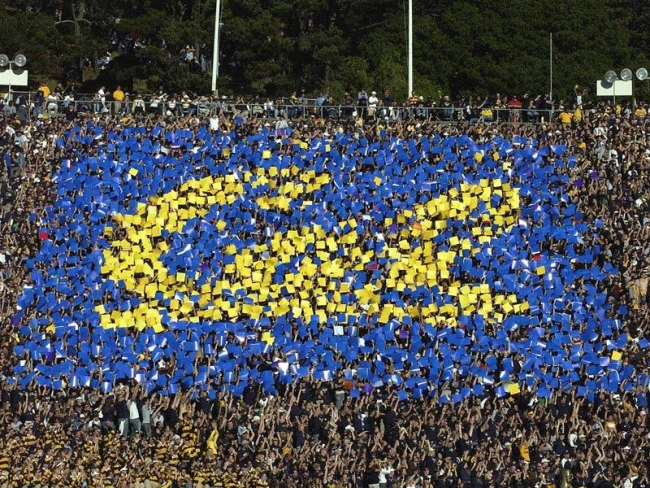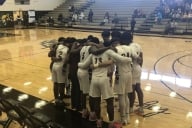You have /5 articles left.
Sign up for a free account or log in.

U. of California at Berkeley
When describing the approach that administrators at the University of California at Berkeley took to the university's sports program, John Cummins consistently uses a somewhat unexpected term: ambivalent.
Unexpected, says Cummins, a former associate chancellor at the university, because Berkeley, like all other big-time football programs in the major athletic conferences, is in a “spending race” on facilities, coaching salaries and conference-related travel in order to lure – or, as the paper puts it, “in the hopes of luring” – the best recruits.
Because the university continues to admit underprepared students because of their athletic prowess, he says, despite football boasting the lowest graduation rate (44 percent) of athletes of any Division I program this year, and despite athletes consistently graduating at lower rates (especially black athletes) than non-athletes do.
And because administrators have allowed the athletics department to move further and further outside the institution and operate simply as a business, he argues, no matter what deficits, internal conflicts, scandals and National Collegiate Athletic Association violations ensue.
Given the general direction of things, that all sounds pretty purposeful, not evidence of ambivalence.
The problem, Cummins and a graduate student and athlete, Kirsten Hextrum, argue in a white paper published by Berkeley’s Center for Studies in Higher Education and presented to the university's Athletic Study Center Advisory Committee, is that Berkeley has never really figured out – much less articulated – the role of athletics within the university. There are no clear values guiding decision-making.
As a result, over the years, athletics (namely football and men’s basketball) has exploded as administrative turnover continued, with no chancellor or administrator ever being able to give due consideration to the implications for the rest of the institution.
“Rather than resolving the dilemma of how to maintain a nearly $70 million per year athletic enterprise while still providing a world-class education for the participants, campus administrators continue to muddle through,” write Hextrum and Cummins, who served in various administrative positions from 1972 through his retirement in 2008.
“I think there is real value that intercollegiate athletics provides to a student-athlete…. The teamwork, the dedication, the discipline that being an intercollegiate athlete requires,” Cummins said in an interview. “But whether so much money has to be spent on it I think is where the real conflict arises: the commercialism, the huge amounts of money involved, the tremendous pressure to win and then the effect that has on the educational program, which is typically negative.”
Because the paper is an exhaustive examination of the history of athletics at Berkeley alone, the authors do not claim their conclusions and recommendations apply to all colleges with big-time sports programs. Many others may grapple with the same issues (excessive spending, low graduation rates, etc.), but have different academic or administrative cultures.
It's an important distinction because the paper’s proposed solution – truly integrating athletics and academics – is complex and probably wouldn't look the same at every institution.
And it might be easier said than done.
“It’s a noble concept,” said Jason Lanter, an assistant professor of psychology at Kutztown University of Pennsylvania and past-president of the Drake Group, which advocates more faculty voice in athletics. But, he added, that ship may have already sailed.
“The philosophical mission of those two enterprises – of athletics and academics – are kind of in direct competition,” Lanter said. “There needs to be more faculty and administrator oversight of athletics, but how that integration is going to occur will be a very delicate matter."
First and foremost, he said, those missions have to change to give athletes the education they came for and avoid situations such as occurred with the University of North Carolina at Chapel Hill's no-show classes scandal. “Athletics has tended to run amok and do its own thing individually, sometimes at the expense of academics and sometimes without any academic oversight whatsoever.”
Cummins points to numerous examples. At Berkeley, 25 percent of football players are special admits -- or, as Cal calls them, “intensives”: students whose academic credentials greatly differ from the norm and who require an exceptional amount of academic support. Those students are three times more likely to end up on academic probation. There’s also the issue of over-practicing, an open secret on the Berkeley campus (and many others). Facing pressure from coaches to perform, athletes often exceed the NCAA-mandated 20-hour limit on organized sport activity, sucking up time that could be spent, say, studying.
There are non-academic conflicts, too. Some faculty have complained about Berkeley, on top of multimillion-dollar annual institutional subsidies, loaning the athletic department money to cover budget deficits, and in 2007, forgiving $31 million in loans. Then, in 2010, the university announced it would eliminate four non-revenue sports as a cost-cutting measure. After widespread outcry, administrators changed their minds.
“I think, basically, the institution lost focus,” Cummins said. “The whole purpose of the NCAA, from its inception, was to say that there is a connection between the academic program and intercollegiate athletics program, and if there is, then you should make every effort to do that.… Institutions have to decide. If it’s going to be a separate entity, then say it.”
Reached for comment, a Berkeley athletics spokesman referred to another paper, written in response to the white paper. In it, two faculty members -- Bob Jacobsen, physics professor and faculty athletics representative, and Richard Rhodes, associate linguistics professor -- defend the special admit system and argue that the larger issue is cultural, not institutional. (However, they did fault faculty for pre-judging athletes as incompetent – sometimes to the media or to their faces.) Athletes in certain sports, they say, simply stop attending classes once their athletic eligibility expires, and the frequency with which this happens seems to vary from coach to coach.
While clearly critical of Cummins’s assertions, calling the idea that low graduation rates are due to admitting unqualified students “false,” the professors appear to agree with him on the solution.
“We’re really talking about better integrating student athletes into the academic life of the campus. Some teams, some coaches do this better than others, but on average there is a troubling disconnect between the student-athlete community and the larger academic community,” the professors write. “If a problem like [low graduation rates] surfaced during the provost’s review of an academic department, the reaction would be clear: It’s the department’s responsibility, make a plan and get this corrected…. It should be the coaches’ responsibility to make sure their student athletes are engaged.”
Cummins and Hextrum argue for a new sort of athletic department, one that’s closely intertwined with the institution’s academic enterprise and includes a direct reporting line from the athletics director to the chief academic officer. Athletes would live and study with everyone else. The university would offer a legitimate sports-related academic program, like those at the Universities of Michigan and North Carolina at Chapel Hill, demonstrating the value of sport in society. Athletes with substandard academic credentials would no longer be admitted on the basis of their sport.
The general idea is to recognize that athletes really are students first, as NCAA President Mark Emmert says constantly, and should be treated like any other student.
The authors acknowledge that their paper could be, and very well might be, easily brushed off. But they’re hopeful that with lots of local attention on athletes’ academic troubles and renewed institutional focus (and progress) on athletes’ academic performance, change is possible.
“It’s kind of a great opportunity, I think, for the institution to take advantage of this crisis and say ‘O.K., you know, we’re going to do this right and do it right for the long term,' ” Cummins said. “That’s certainly what I would hope.”








